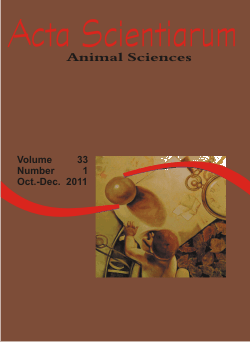<b>Tiller number in signalgrass under continuous stocking systems</b> - doi: 10.4025/actascianimsci.v33i1.10440
Keywords:
sward height, Brachiaria decumbens, season, seasonal management, grazing
Abstract
The study was conducted to identify, through assessments of tillering, appropriate management strategies for Brachiaria decumbens cv. Basilisk under continuous stocking with cattle. Two management strategies were studied: pasture with 25 cm throughout the experimental period, and pasture with 15 cm in winter and 25 cm in spring and summer. A split-plot and randomized block design with four replications were adopted. The management strategies represented the primary factor, and the seasons (winter, spring and summer) were the secondary factor. The lowest balance between rates of appearance (TAR) and mortality (TMR) of tillers and the lowest number of vegetative tillers occurred in winter. In spring and summer, the balance and number of vegetative tillers were higher and did not differ. The lowering of pasture in winter resulted in greater balance between TAR and TMR and higher number of tillers in relation to management on sward fixed at 25 cm. There were greater numbers of reproductive and dead tillers in summer and winter, respectively. The pastures with fixed height of 25 cm contained a higher number of dead tiller. Under continuous stocking, the lowering of B. decumbens pasture in winter and its increase to 25 cm in spring and summer optimizes turnover of tillers.Downloads
Download data is not yet available.
Published
2011-02-02
How to Cite
Santos, M. E. R., Gomes, V. M., Fonseca, D. M. da, Albino, R. L., Silva, S. P. da, & Santos, A. L. (2011). <b>Tiller number in signalgrass under continuous stocking systems</b> - doi: 10.4025/actascianimsci.v33i1.10440. Acta Scientiarum. Animal Sciences, 33(1), 1-7. https://doi.org/10.4025/actascianimsci.v33i1.10440
Issue
Section
Pasture and forage utilization
DECLARATION OF ORIGINALITY AND COPYRIGHTS
- I Declare that current article is original and has not been submitted for publication, in part or in whole, to any other national or international journal.
The copyrights belong exclusively to the authors. Published content is licensed under Creative Commons Attribution 4.0 (CC BY 4.0) guidelines, which allows sharing (copy and distribution of the material in any medium or format) and adaptation (remix, transform, and build upon the material) for any purpose, even commercially, under the terms of attribution.
Read this link for further information on how to use CC BY 4.0 properly.
0.9
2019CiteScore
29th percentile
Powered by 








































